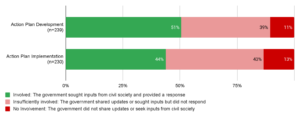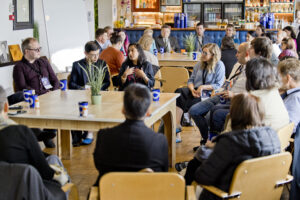Four Takeaways from our Stakeholder Survey
A core tenet of the OGP model is that regular feedback leads to more effective policies. For this reason, over the past two years, we (the OGP Support Unit) have continued to survey our civil society partners to learn how the OGP process is working (see past results here). Below are four takeaways from the survey results, including how they relate to the new OGP strategy.
1. Civil society is growing more positive about OGP’s potential
About two-thirds of civil society respondents became more positive about OGP’s potential to deliver change (see Figure 1). About one-third of respondents indicated that they grew “much more positive”, many of them at the local level. This enthusiasm is essential to the success of the open government movement. The goal of the new strategy is to translate this positive energyEnsuring universal access to sustainable, dependable, and affordable energy is critical to every aspect of prosperity. Increasing public oversight and transparency in the energy sector can help to ens... More into concrete opportunities for reforms that address society’s most pressing challenges.
Figure 1. Civil society is generally becoming more positive about OGP
The survey asked, “In the past 18-24 months, have you become more or less positive about the potential of OGP to deliver change in your jurisdiction?” (n=360)

At the same time, a growing number of survey respondents – one in five – became less positive about OGP’s potential. This also came through in the OGP strategy consultation, which led us to prioritize actions such as strengthening the OGP action framework, better protecting civic space, and investing in inspiration from and recognition of reforms and reformers.
2. Most action plans include a majority of civil society priorities
Co-created action plans should reflect a variety of perspectives. In the survey, nearly two-thirds of civil society respondents noted that their latest action plan includes a majority or all of their priorities (see Figure 2). Unsurprisingly, the survey showed that action plans were more likely to include civil society priorities in the presence of an OGP multi-stakeholder forum. The evidence shows that when civil society is involved in spaces such as these, commitments are more ambitious and yield stronger early results. Establishing a forum continues to be a requirement for all OGP members.
Figure 2. Most action plans include a majority of civil society priorities
The survey asked, “To what extent does the action planAction plans are at the core of a government’s participation in OGP. They are the product of a co-creation process in which government and civil society jointly develop commitments to open governmen... of your country match open government priorities identified by civil society?” (n=235)

3. Civil society participates meaningfully in most OGP processes
All OGP national governments are required to gather inputs from stakeholders and report back on how contributions were considered. About half of civil society respondents said that their government met these steps during action plan development (see Figure 3). Another 40 percent were informed or consulted, but did not engage in two-way dialogue with their government.
Figure 3. The level of civil society involvement in OGP action plans varies
The 2022 survey asked, “In your view [as a civil society respondent], to what extent does your government involve civil society in OGP during action plan development/implementation?”

As we’ve documented before, civil society tends to be less involved in action plan implementation than in co-creation. Here too, respondents were more likely to be involved if an OGP multi-stakeholder forum existed. Fortunately, the evidence shows that civil society involvement in OGP processes continues to grow over time.
4. More civil society actors are getting involved in OGP
Nearly three in five respondents indicated that more civil society actors are getting involved in the OGP process (see Figure 4). In contrast, only one in five reported that fewer people are getting involved. Building a growing and interconnected community of open government reformers is a key pillar of the new strategy. Expanding the community to include more local and subnational leaders, parliamentarians, youthRecognizing that investing in youth means investing in a better future, OGP participating governments are creating meaningful opportunities for youth to participate in government processes. Technical ... More organizations, groups working on genderOGP participating governments are bringing gender perspectives to popular policy areas, ensuring diversity in participatory processes, and specifically targeting gender gaps in policies to address gov... More equity, academics, and private-sector representatives, among others, will be vital to drive change.
Figure 4. More civil society actors are participating in the OGP process
The survey asked, “In the past 18-24 months, have more or fewer civil society actors become involved in the OGP process in your jurisdiction?” (n=232)

Together, the four takeaways above point to an OGP civil society community that is by and large optimistic and engaged. Going forward, this vibrancy will be essential to build a stronger global movement of open government leaders and coalitions that take action together. Ultimately, the success of OGP’s new strategy will depend not on individuals but on the efforts of the community as a collective to coordinate, collaborate, and together carry out transformative reform.


Leave a Reply